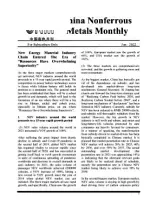Export Volume Increases While Price Drops: Three Major Factors Weakens Our Country’s Rare Earth Industry
2014-08-15
According to data recently disclosed by the Hohhot Customs of Inner Mongolia, in 2013, the volume of rare earth exported through the Hohhot Customs was 5,065 tons, slightly increased compared with 2012, but the export price dropped by 50%. Rare earth enterprises in Inner Mongolia can get 25% of the entire country’s rare earth export quota. Therefore, the volume increase and price decrease of rare earth export in Inner Mongolia can reflect the weakened development of the rare earth industry in 2013.
Since the 3rd quarter of 2011, Inner Mongolia’s rare earth industry has shown a downward trend, reflected in the falling price and shrinking export. The price monitor of Baotou Municipal Economic and Information Technology Commission indicates that in July 2012, the price of rare earth carbonate in Baotou was RMB 68,000 per ton, down by RMB 23,000 per ton compared with the high point of July 2011, and the price dropped to RMB 27,000 per ton in July 2013; after November 2013, the price of neodymium oxide, which is called the “weather-vane of the rare earth market”, went down to RMB320,000, RMB110,000 less than that of July 2012.
The continuously sliding market has brought huge difficulties for enterprises. It is learnt that currently about 70% of neodymium production capacity is idle in the Baotou area, and there is serious underproduction in smelting and separation enterprises. Although supported by government purchasing and storage, revenues of the first three quarters of 2013 of Bao Steel Rare Earth (the parent company) suffered a sharp drop of 50% year on year, and profit shrank to be only RMB 2.3 billion. Rare earth export was even worse. In 2012, actual rare earth export quantity was 4,086 tons in the Baotou area, which was only 50% of the export quota. In 2013, there was still surplus export quota in the Baotou area.
It is believed in the industry that the following three factors contribute to the weakening of the rare earth industry.
First of all, the impact from the black rare earth industrial chain. At one rare earth industrial conference, the Secretary-General of China Rare Earth Industry Association Ma Rongzhang disclosed that it was estimated that rare earth production exceeding plan or without plan accounts for 50% of the total sales. Illegal production enterprises rely on stealing raw material, and they escape from environmental supervision in the production process; moreover, they evade taxes in their sales, consequently their production cost is extremely low. The black rare earth industrial chain hampers the sales of legitimate products, exacerbating the difficulties of legitimate production and the slump of the market.
Secondly, the contradiction between demand and production capacity aggravates the sluggishness of the market. In the past two years, the world economy has experienced slow recovery, and the demand for rare earth slows down, with major rare earth importing countries like the US, Japan and European Community cutting their rare earth import. Meanwhile, after the 3rd quarter of 2011, due to the price hike of rare earth in the country, some low end rare earth applications have exited the market because of cost pressure. In 2012, global market demand for rare earth was less than 100,000 tons, and although there was slight increase in 2013, the incremental was far from enough to absorb our country’s rare earth production capacity, and the consumption throughout the year was estimated to be less than 200,000 tons. It is estimated that our country’s rare earth smelting and separation capacity is 320,000 tons, and the existing neodymium production capacity and that under construction amount to 400,000 tons.
Thirdly, technological progress weakens the rare earth consumption intensity. The jump in rare earth price in recent years has forced rare earth application enterprises to reduce the usage of rare earth or look for alternative materials through technical innovation. In the rare earth market seminar held in November 2013, industrial sources pointed out that currently the development trend of rare earth permanent magnet device is lightweight and thinness. Although the demand volume for rare earth device will increase, the demand for rare earth will not grow simultaneously; actually it will even drop. Rare earth permanent material is the most important area for rare earth consumption, and the less usage of rare earth will bring huge pressure on the market. Besides, benefiting from technical advancement, there is a trend for LED to replace rare earth efficient light bulb. LED uses much less rare earth than fluorescent lamp does, and this will significantly reduce the global demand for rare earth phosphor powder.
杂志排行
China Nonferrous Metals Monthly的其它文章
- The State Will Fully Support Leading Secondary Metal Enterprises and Raise the Industrial Access Threshold
- Chifeng to Build RMB200 Billion Nonferrous Metals Club
- The Country’s New Policy Represents a Major Challenge for Lead Enterprises in Henan
- The Ministry of Land and Resources Published the “Three-Rate” Indicator for Seven Minerals Including Iron Ore and Copper
- Tibet’s Duolong Is Expected to Become a World-class Copper-Gold Mining Base
- It is Imperative for Chinese Enterprises to Change their Investment Model in Overseas Mining Industry
